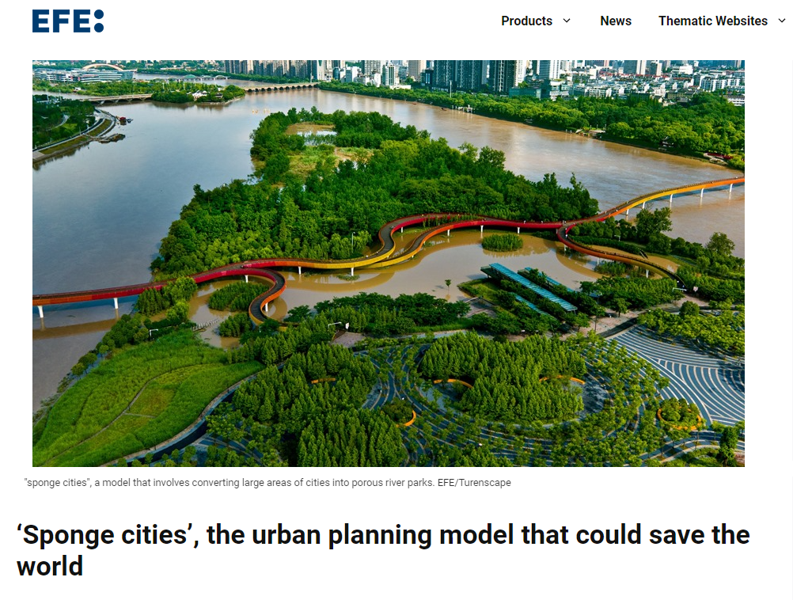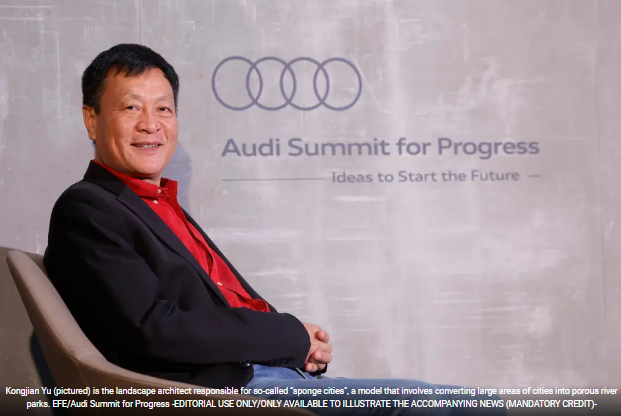EFE: '海绵城市'拯救世界的城市规划模式

Madrid, Oct 25 (EFE).- Modern challenges such as floods, rising global temperatures and water shortages can be mitigated with a holistic but revolutionary approach – turning the planet into a sponge, a strategy that is already being deployed in more than 250 cities.
Kongjian Yu is the landscape architect responsible for the “sponge cities” model that consists of transforming large urban areas into porous parks capable of retaining and filtering water.
In practice, these “sponge cities” are large public green areas in which futuristic design and modernity go hand in hand, in keeping with the urban planning present in big modern cities.
They are huge esplanades capable of retaining and filtering rain or riverbeds underground, which also helps keep temperatures lower, create new vegetation, ponds and control and slow down the natural course of water, even during major flooding events.
“Current urban planning models fail in extreme situations. Humanity is at a crossroads in deciding which model to follow. We aspire to save the planet and turn it into a sponge,” stresses Kongjian Yu in an interview with Efe.
Yu, who has the landscape architecture firm Turenscape with about 400 employees, has successfully designed projects of ‘sponge cities’ in China, Thailand, the United States, in places like Boston and Seattle, or Europe, with a recent design in the city of Paris.
In this regard, he believes that “the answer to natural disasters is found in nature itself. Turning it into a sponge means reducing the temperature of the planet, making it lush, humid, productive,” he adds.
Now 60 years old, the Chinese landscape architect acknowledges that his entire urban planning theory for alleviating natural disasters caused by floods is based on his experience in the small village where he was born in the coastal province of Zhejiang, in the east of the country.

“Water is not the enemy. We didn’t have money to build canals so we used nature itself. But if you build walls, then water can become a beast. It becomes destructive. If we create big concrete infrastructure to contain the water, we will fail again,” he stresses.
ECOLOGICAL CIVILIZATION
To that end, his “ecological civilization” projects combine design with a sustainable approach. “That’s why you need a different model, different mentality, different development philosophy. We don’t rely on infrastructure or big technology, which are not resilient,” he says.
Is totally different philosophy says philosophy is based on ecology is based on ecological we call the ecological civilization.
Yu, recently awarded the Oberlander International Prize for Landscape Architecture 2023, does not support the current model of urbanism which is based on “huge unsustainable investments” in projects such as dams, huge retaining walls or canalizations and pipes that have proven to be ineffective in preventing catastrophic floods.
In his opinion, what is needed is “a permanent, infallible, resilient, sustainable and multifunctional holistic solution. The number one priority is to allow water retention with porous soils. Demolish all the concrete, the ‘gray infrastructure,'” as it alters the natural course of water, also eradicating green areas.
“It has been proven that with torrential rains (traditional in monsoon areas or caused by climate change) cities’ pipe systems collapse,” he adds.
In China, more than 70 cities have implemented this model, as part of the government’s goal to have 80% of the country’s cities absorb and use 70% of rainfall by 2030.
“Landscape architecture is the art of survival (…). All these techniques are simple, they are learned from agriculture, from my own experience as a farmer. And these techniques work with nature,” he concludes. EFE
